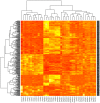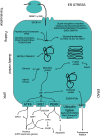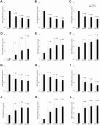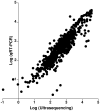Molecular effects of doxycycline treatment on pterygium as revealed by massive transcriptome sequencing
- PMID: 22724003
- PMCID: PMC3378547
- DOI: 10.1371/journal.pone.0039359
Molecular effects of doxycycline treatment on pterygium as revealed by massive transcriptome sequencing
Abstract
Pterygium is a lesion of the eye surface which involves cell proliferation, migration, angiogenesis, fibrosis, and extracellular matrix remodelling. Surgery is the only approved method to treat this disorder, but high recurrence rates are common. Recently, it has been shown in a mouse model that treatment with doxycycline resulted in reduction of the pterygium lesions. Here we study the mechanism(s) of action by which doxycycline achieves these results, using massive sequencing techniques. Surgically removed pterygia from 10 consecutive patients were set in short term culture and exposed to 0 (control), 50, 200, and 500 µg/ml doxycycline for 24 h, their mRNA was purified, reverse transcribed and sequenced through Illumina's massive sequencing protocols. Acquired data were subjected to quantile normalization and analyzed using cytoscape plugin software to explore the pathways involved. False discovery rate (FDR) methods were used to identify 332 genes which modified their expression in a dose-dependent manner upon exposure to doxycycline. The more represented cellular pathways included all mitochondrial genes, the endoplasmic reticulum stress response, integrins and extracellular matrix components, and growth factors. A high correlation was obtained when comparing ultrasequencing data with qRT-PCR and ELISA results. Doxycycline significantly modified the expression of important cellular pathways in pterygium cells, in a way which is consistent with the observed efficacy of this antibiotic to reduce pterygium lesions in a mouse model. Clinical trials are under way to demonstrate whether there is a benefit for human patients.
Conflict of interest statement
Figures








References
-
- Coroneo M. Ultraviolet radiation and the anterior eye. Eye Contact Lens 37: 214–224. 2011. 10.1097/ICL.0b013e318223394e [doi] - PubMed
-
- Bradley JC, Yang W, Bradley RH, Reid TW, Schwab IR. The science of pterygia. Br J Ophthalmol 94: 815–820. 2010. bjo.2008.151852 [pii];10.1136/bjo.2008.151852 [doi] - PubMed
-
- Chui J, Di GN, Wakefield D, Coroneo MT. The pathogenesis of pterygium: current concepts and their therapeutic implications. Ocul Surf. 2008;6:24–43. - PubMed
Publication types
MeSH terms
Substances
LinkOut - more resources
Full Text Sources

